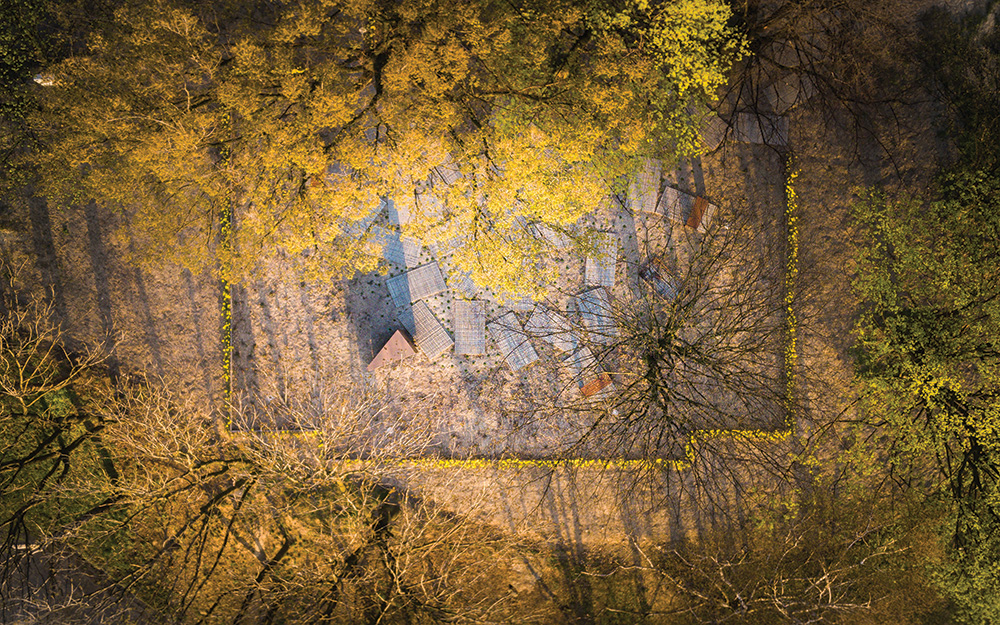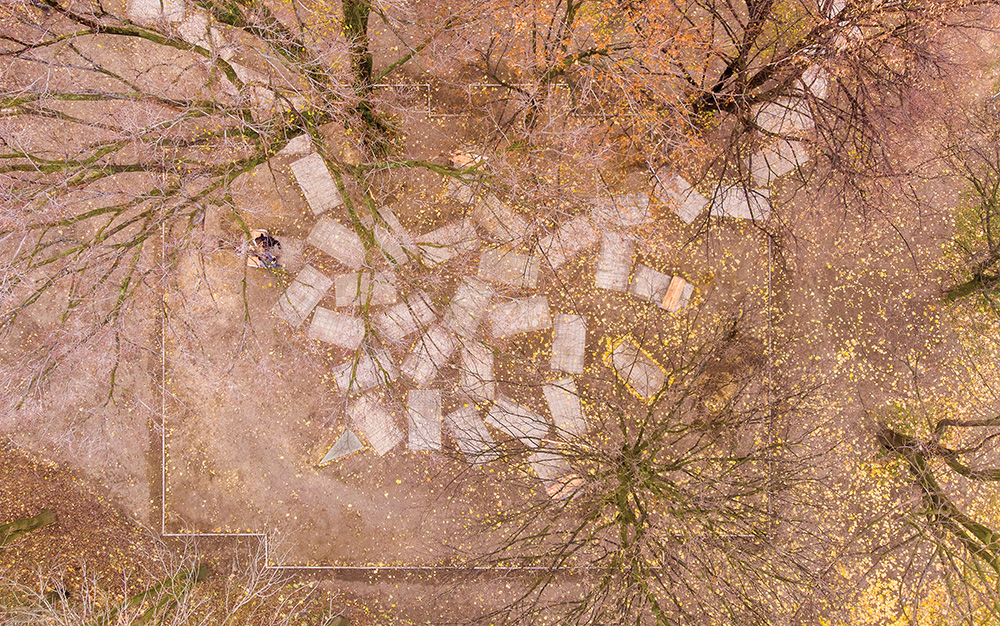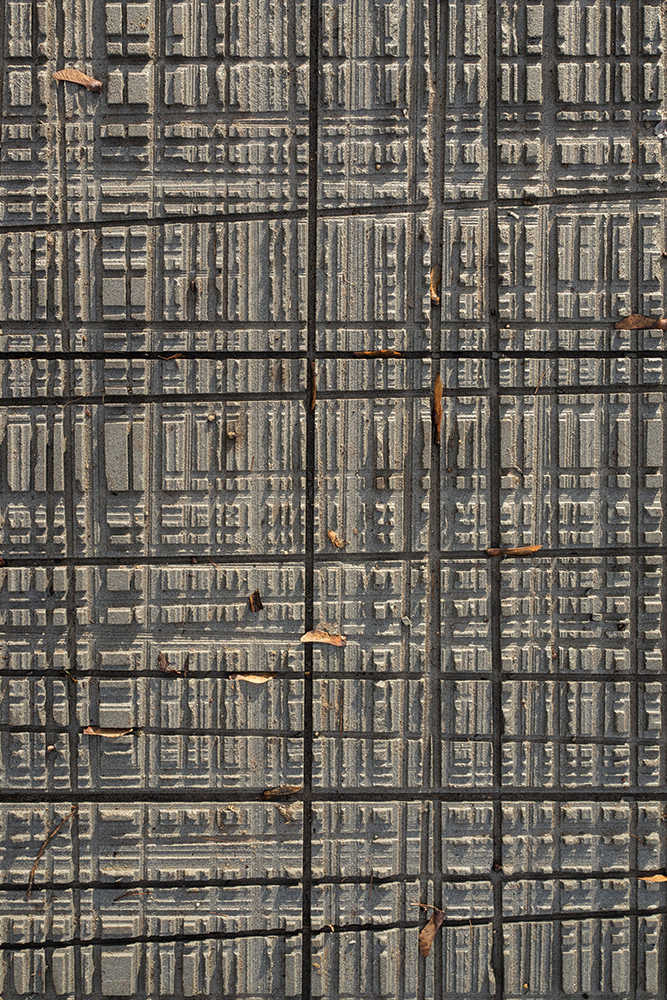本文由NArchitekTURA授权mooool发表,欢迎转发,禁止以mooool编辑版本转载。
Thank NArchitekTURA for authorizing the publication of the project on mooool, Text description provided by NArchitekTURA.
NArchitekTURA:大约十年前,设计师偶遇一种美丽的工业废料:灰色的砂岩板,板面上有无数不规则的切口。多年来,他一直在寻找适当的机会将这种材料应用于实际项目。他在奥斯威辛市的这个项目上实现了这个目标。砂岩板在这里成为了纪念公园的主旋律,象征着现已解散的大犹太教堂(1863-1939)的废墟,也象征曾经的多元文化社区的生活之路在此纵横交错。
NArchitekTURA:Almost a decade ago, I accidentally came across a beautiful industrial waste material – grey sandstone slabs with countless irregular cuts. For many years I was looking for an adequate design opportunity to take advantage of this singular material. Finally, I found the right project in the city of Oświęcim, where it became the leitmotiv of the Memorial Park, symbolizing the ruins of the now-defunct Great Synagogue (1863-1939) and the paths of life of the multicultural community that were once crisscrossing in this place.
这座80年前被拆除的犹太教堂以各种形式反应在该项目上。前犹太教堂的区域由狭窄路牙石划分出来,将公园的内部与周围茂密的植物隔离开来。
References to the temple demolished 80 years ago take on various forms in the new project. The outline of the former synagogue is marked by a narrow curb, separating the interior of the park from the dense greenery surrounding it.
设计的主要元素是四十个灰色砂岩板形成的马赛克图案。它们的不规则排列与前犹太教堂的遗迹相呼应(特别是其地板,由类似的石材制成)。石板铺就成通向公园其他元素的路径:一个户外展览模块,展示犹太教堂的历史;一口带有历史楼层的“井”;浅水池塘;耐候钢长凳和枝形吊灯。这些元素的尺寸、形状和颜色不仅与犹太传统有关,而且还具有普遍的象征意义。这个新的空间四面开放,接纳所有的不同。
The main element of the park’s arrangement is a mosaic of forty grey sandstone slabs. Their irregular arrangement echoes the remains of the former synagogue (particularly its floor, made of similar stone material). Individual slabs form paths leading to other elements of the park: an outdoor exhibition module presenting the history of the synagogue (stylistically referring to our previous project of the nearby Auschwitz Jewish Center), a “well” with the historical floor (planned in the next stage of the development), a shallow water pond, Corten benches and a chandelier (which is a copy of an artefact found here during archaeological works). Dimensions, shapes and colours of these new forms are all associated not only with Jewish tradition but also with universal symbolism, legible for different confessions and cultures. This new space has an open character allowing for different ways of using, commemorating and interpreting.
“人生之路”这个主题主要以独特的材质体现出来。120 x 220厘米的灰色砂岩板表面布满不同深度的凹槽组成的“饰条”。这些切入的线条形成了一种奇异的“浮雕”,在不同的阳光角度和强度下,不同的天气情况下,外观会有所不同。有趣的是,这种几何图案不是由设计师设计出来的,而是偶然形成。这种材料被归类为工业废料,在奥斯维辛市被重新利用,借此表达对过度开采自然资源的反对意见。
The illustration of the „paths of life” title idea manifests itself mainly in the form of a unique material solution. The 120 x 220 cm grey sandstone slabs are decorated with “frieze” made up of countless grooves of varying depths. These cut-in-stone lines create a kind of singular “relief” that changes its appearance depending on the angle of sunlight and its intensity, or atmospheric conditions – rain, snow etc. Interestingly, this geometric pattern does not result from the work of architects using the latest technologies but was created quite by accident. Classified as industrial waste, they were reused and “brought back to life” in the city of Oświęcim – as a gesture of opposition to excessive exploitation of natural resources.
纵横交错的切入线也具有象征意义,它们没有明确的起点或终点,仿佛走向无限。密集的线条被比喻为生活之路,看似只是交错而过,其实却相互连接在一起。抽象的马赛克图案也隐射因为战争而不复存在的城市布局和街道。该项目旨在保留过去的记忆,以对未来发出警告,但同时庆祝当下的和平。也许经过几百年的时间,这个地方将成为一个神秘的考古遗址,那时的人们会如何解读这四十块砂岩板上的信息呢?
The crisscrossing cut-in-stone lines also take on a symbolic dimension. Without any clear beginning or end, they seem to be heading towards infinity. This dense network of lines evokes the paths of human life, that sometimes just intersect, and at other times connect to go on together. A seemingly abstract mosaic may also resemble the now-defunct urban layout of a pre-war city – its streets, pavements and buildings. This „cut-in-stone” history of Oświęcim, the Great Synagogue and the ruins remaining after its destruction aims at preserving the memory of the past, with a warning message for the future, at the same time beautifully celebrating the present. Who knows, maybe after a few hundred years time, this place will become a mysterious archaeological site? After all, throughout centuries, humanity has been learning about ancient times from illustrations and texts immortalized in stone. I often wonder how will be interpreted in the distant future the message hidden in the forty pieces of the Memorial Park?
项目名称:奥斯维辛犹太教堂纪念公园
项目地点:波兰,奥斯维辛
完成时间:2020年
面积:693平方米
设计公司:NArchitekTURA
主创设计师:Bartosz Haduch, Łukasz Marjański
合作方:Magdalena Poprawska, Maria Koczur, Robert Haponik
客户:Auschwitz Jewish Center
摄影师:Piotr Strycharski, Bartosz Haduch
Project name: The Great Synagogue Memorial Park in Oświęcim
Project location: Berka Joselewicza 5, 32-600 Oświęcim
Completion Year: 2020
Size: 693 sqm
Landscape/Architecture Firm: NArchitekTURA
Lead Architects: Bartosz Haduch, Łukasz Marjański
Collaborators: Magdalena Poprawska, Maria Koczur, Robert Haponik
Clients: Auschwitz Jewish Center
Photo credits: Piotr Strycharski, Bartosz Haduch
更多 Read more about: NArchitekTURA












0 Comments